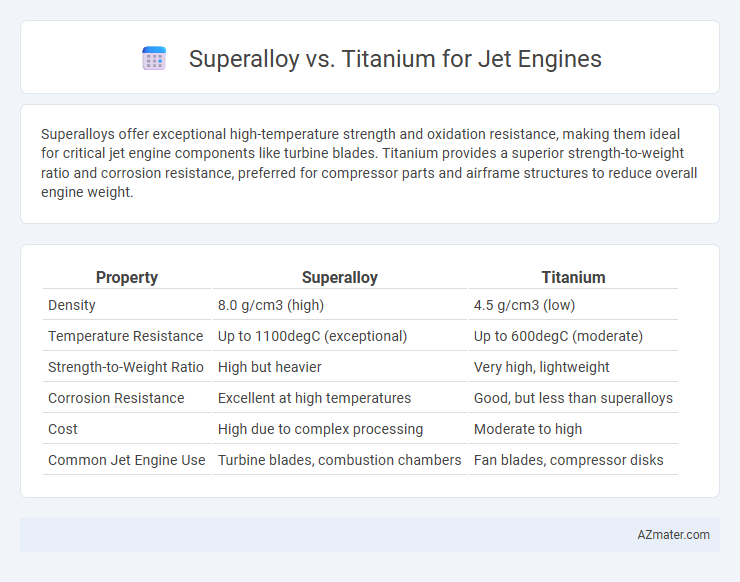Superalloys offer exceptional high-temperature strength and oxidation resistance, making them ideal for critical jet engine components like turbine blades. Titanium provides a superior strength-to-weight ratio and corrosion resistance, preferred for compressor parts and airframe structures to reduce overall engine weight.
Table of Comparison
| Property | Superalloy | Titanium |
|---|---|---|
| Density | 8.0 g/cm3 (high) | 4.5 g/cm3 (low) |
| Temperature Resistance | Up to 1100degC (exceptional) | Up to 600degC (moderate) |
| Strength-to-Weight Ratio | High but heavier | Very high, lightweight |
| Corrosion Resistance | Excellent at high temperatures | Good, but less than superalloys |
| Cost | High due to complex processing | Moderate to high |
| Common Jet Engine Use | Turbine blades, combustion chambers | Fan blades, compressor disks |
Introduction to Jet Engine Materials
Superalloys and titanium are critical materials used in jet engine construction due to their exceptional performance in extreme environments. Superalloys, primarily nickel-based, provide outstanding high-temperature strength and oxidation resistance essential for turbine blades and combustion chambers. Titanium alloys offer excellent strength-to-weight ratios and corrosion resistance, making them ideal for compressor components and fan blades in modern jet engines.
Properties of Superalloys
Superalloys for jet engines exhibit exceptional high-temperature strength, corrosion resistance, and creep resistance, making them ideal for turbine blades and combustion chambers. Their complex microstructure, often based on nickel, cobalt, or iron, enables superior mechanical properties at temperatures exceeding 1000degC. These properties allow superalloys to withstand extreme thermal and mechanical stresses that titanium alloys cannot endure efficiently in jet engine applications.
Properties of Titanium Alloys
Titanium alloys exhibit exceptional strength-to-weight ratios, making them ideal for jet engine components requiring both durability and lightweight characteristics. Their high corrosion resistance and ability to maintain mechanical properties at elevated temperatures up to approximately 600degC enhance engine efficiency and lifespan. Titanium alloys' excellent fatigue resistance and fracture toughness contribute to the reliability and safety of critical aerospace parts under cyclic stress conditions.
Thermal Resistance Comparison
Superalloys, primarily nickel-based, exhibit exceptional thermal resistance, maintaining structural integrity at temperatures above 1,000degC, which is critical for jet engine turbine blades exposed to extreme heat and stress. Titanium alloys offer lower density and improved oxidation resistance up to around 600degC but lack the high-temperature performance of superalloys, limiting their use to cooler engine components like compressor blades. Superior thermal resistance of superalloys enables higher operating temperatures, improving engine efficiency and performance compared to titanium in jet engine applications.
Strength-to-Weight Ratio Analysis
Superalloys exhibit exceptional high-temperature strength and corrosion resistance crucial for jet engine turbine blades, but their density results in a lower strength-to-weight ratio compared to titanium alloys. Titanium alloys provide superior strength-to-weight ratios due to their lower density and excellent fatigue resistance, making them ideal for compressor components where weight reduction is critical. Optimizing engine performance involves balancing the superior thermal capabilities of superalloys with the lightweight, high-strength advantages of titanium to enhance overall efficiency.
Corrosion and Oxidation Resistance
Superalloys exhibit exceptional corrosion and oxidation resistance at high temperatures due to their complex compositions, including elements like chromium, aluminum, and cobalt that form protective oxide layers. Titanium alloys offer good corrosion resistance, particularly against oxidizing environments, but their oxidation resistance diminishes significantly above 600degC, limiting their use in the hottest jet engine sections. In jet engine applications, superalloys are preferred for turbine blades where extreme oxidation resistance and mechanical strength at elevated temperatures are critical, while titanium alloys are suited for cooler sections where corrosion resistance and weight reduction are prioritized.
Manufacturing and Machinability
Superalloys, primarily nickel-based, exhibit excellent high-temperature strength and corrosion resistance but pose significant challenges in manufacturing due to their hardness and work-hardening properties, requiring specialized tools and slower machining speeds. Titanium alloys offer a favorable strength-to-weight ratio and better machinability compared to superalloys, allowing for faster machining with less tool wear, though they still require careful thermal management to avoid galling and tool degradation. Manufacturing processes for superalloys often involve complex casting or forging techniques, whereas titanium's reactivity mandates inert atmosphere machining or advanced cooling methods to maintain material integrity during production.
Cost and Availability Factors
Superalloys, primarily based on nickel, exhibit higher material costs due to complex processing and expensive alloying elements, yet they remain widely available through established supply chains in aerospace manufacturing. Titanium, despite its superior strength-to-weight ratio and corrosion resistance, often incurs higher raw material and machining expenses, with availability sometimes constrained by limited extraction and refining capacities. Cost-efficiency in jet engine production depends on balancing superalloys' thermal performance and widespread procurement against titanium's weight savings and variable market supply.
Typical Applications in Jet Engines
Superalloys are predominantly used in jet engine turbine blades and combustion chambers due to their exceptional high-temperature strength and resistance to oxidation and creep. Titanium alloys are typically employed in compressor blades and fan disks, where their high strength-to-weight ratio and corrosion resistance improve fuel efficiency and reduce overall engine weight. The complementary use of superalloys and titanium optimizes engine performance by balancing temperature tolerance and mechanical durability across different engine sections.
Future Trends in Jet Engine Materials
Superalloys remain essential in jet engines due to their exceptional high-temperature strength and oxidation resistance, but titanium is gaining prominence for components where weight reduction is critical, offering superior corrosion resistance and lower density. Future trends in jet engine materials emphasize advanced superalloy compositions with improved creep resistance and thermal stability alongside titanium matrix composites that promise enhanced strength-to-weight ratios and fuel efficiency. Research is rapidly advancing toward hybrid material architectures combining superalloys and titanium alloys to optimize performance, durability, and sustainability in next-generation aerospace propulsion systems.

Infographic: Superalloy vs Titanium for Jet engine
 azmater.com
azmater.com